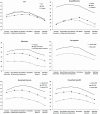A New Look at Cohort Trend and Underlying Mechanisms in Cognitive Functioning
- PMID: 32726439
- PMCID: PMC8436693
- DOI: 10.1093/geronb/gbaa107
A New Look at Cohort Trend and Underlying Mechanisms in Cognitive Functioning
Abstract
Objectives: The prevalence of dementia in the United States seems to have declined over the last few decades. We investigate trends and their underlying mechanisms in cognitive functioning (CF) across 7 decades of birth cohorts from the Greatest Generation to Baby Boomers.
Methods: Data come from 30,191 participants of the 1996-2014 Health and Retirement Study. CF is measured as a summary score on a 35-point cognitive battery of items. We use generalized linear models to examine the trends in CF and explanatory variables across birth cohorts. Then, Karlson-Holm-Breen decomposition method is used to evaluate the contribution of each explanatory variable to the trend of CF.
Results: CF has been improving from the Greatest Generation to Late Children of Depression and War Babies, but then significantly declines since the Early-Baby Boomers and continues into Mid-Baby Boomers. This pattern is observed universally across genders, race/ethnicities, education groups, occupations, income, and wealth quartiles. The worsening CF among Baby Boomers does not originate from childhood conditions, adult education, or occupation. It can be attributed to lower household wealth, lower likelihood of marriage, higher levels of loneliness, depression and psychiatric problems, and more cardiovascular risk factors (e.g., obesity, physical inactivity, hypertension, stroke, diabetes, and heart disease).
Discussion: The worsening CF among Baby Boomers may potentially reverse past favorable trends in dementia as they reach older ages and cognitive impairment becomes more common if no effective interventions and policy responses are in place.
Keywords: Cognition; Cohort analysis; Dementia; Demography; Population aging.
© The Author(s) 2020. Published by Oxford University Press on behalf of The Gerontological Society of America. All rights reserved. For permissions, please e-mail: journals.permissions@oup.com.
Figures
References
-
- Christensen, K, Thinggaard, M, Oksuzyan, A, Steenstrup, T, Andersen-Ranberg, K, Jeune, B, McGue, M, & Vaupel, J W. (2013). Physical and cognitive functioning of people older than 90 years: A comparison of two Danish cohorts born 10 years apart. The Lancet, 382(9903), 1507–1513. doi:10.1016/S0140-6736(13)60777-1 - DOI - PMC - PubMed
Publication types
MeSH terms
Grants and funding
LinkOut - more resources
Full Text Sources
Medical
Miscellaneous


